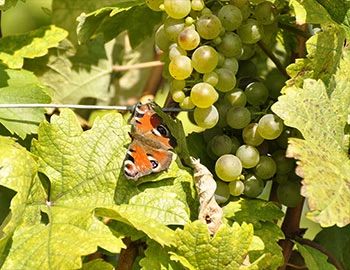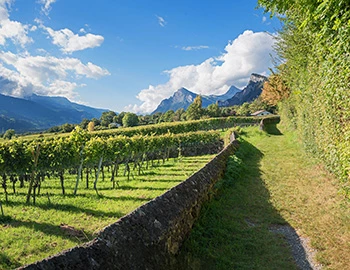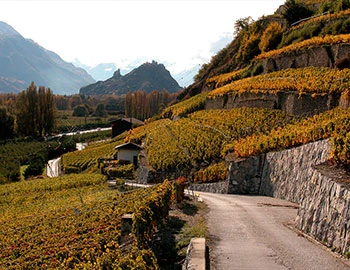Cuvée 1844 Grüner Veltliner 2019
Ostschweizer Landwein, Roland und Karin Lenz, 750 ml

| Grape variety: | Grüner Veltliner |
| Producer: | Roland und Karin Lenz |
| Origin: | Switzerland / Ostschweiz |
Description
Whoever believes that only Austria can produce Grüner Veltliner will have to review their opinion! This representative from the Thurgau exudes a herbal nose reminiscent of meadow herbs, basil and green bell peppers. Fresh notes of Granny Smith and noble vanilla pods complement the fragrance. On the palate, the herbal impression continues with a touch of «pepperiness». Added to this are suggestions of citrus fruit and fennel blossom. The prelude is soft, mouth-watering and refreshing acidity offering immense pleasure in the glass. Decant this white wine, it gains in complexity! Serve it with classics such as Wiener Schnitzel, Caesar salad or pickled salmon.
Attributes
| Origin: | Switzerland / Ostschweiz |
| Grape variety: | Grüner Veltliner |
| Label: | Vegan, Certified organic or biodynamic wine |
| Ripening potential: | 1 to 7 years |
| Drinking temperature: | 10 to 12 °C |
| Food Pairing: | Apéro riche, Italian antipasti, Fish terrine, Asparagus specialities |
| Vinification: | pressed carefully and immediately, fermentation in steel tank, fermentation at low temperatures |
| Harvest: | hand-picking, strict selection |
| Maturation: | in partly new and used barriques/ Pièces, in steel tank, on the yeast, bâtonnage |
| Maturation duration: | 10 months |
| Volume: | 12.0 % |
| Note: | Contains sulphites |
Roland und Karin Lenz
In 1994, while Roland Lenz was still studying oenology, he and his wife Karin were able to acquire eight hectares of vines on the Iselisberg. It was a unique opportunity that they seized, even though they were toying with the idea of setting up their own business abroad, far from Switzerland. They actually did so later, but that's another story…
It is only in the last two decades that the Canton of Thurgau has really come to the attention of wine lovers as a wine-growing area. Its apple orchards and the apple juice (must) pressed from the picked fruit have always been popular, inevitably earning the canton its nickname of «Must India». Viticulture, however, has existed in this region for centuries.

Grüner Veltliner
From Austria to the world
With the Grüner Veltliner, the Austrians have conquered the world. In New York bars today, people order "a glass of Gruner" as nonchalantly as if they have never drunk anything else. Despite its name, it has nothing to do with the northern Italian region of Valtellina (Veltlin in German). It is a natural cross between Traminer and a grape Methuselah with a unique DNA profile, found in Sankt Georgen in the Leitha Mountains. As far as is known, this is the only stock of its kind. Grüner Veltliner demonstrates exceptional versatility. It yields fresh, lively whites with the typical “pfefferl” – a spicy, piquant note – as well as dense, mineral top wines. Sparkling and sweet wines are also pressed from them. In total, it occupies almost two-thirds of Austrian vineyards. It achieves its best along the Danube, around the Kamp Valley, in Kremstal or in the Wachau.

Ostschweiz
Eastern Switzerland: an intriguing puzzle
Eastern Switzerland has long been positioned on the northern rim of the climate zone where the cultivation of popular Swiss varieties is possible. Due to a warming climate, the vineyards of Aargau, Zurich, Schaffhausen, Thurgau and Graubünden are now in the zone where varieties such as Müller-Thurgau or Pinot Noir succeed excellently. But even long-established, almost-forgotten varieties such as Elbling, Räuschling and Completer are experiencing a renaissance.

Switzerland
Switzerland – A small country with enormous diversity
Switzerland is famous for its banks, watches, and cheese, but not necessarily for its wine. The Swiss didn't invent wine, but they have been extremely open and curious to it. Wine culture arrived in what is now modern Switzerland via several routes: from Marseilles to Lake Geneva and the Lower Valais region; from the Aosta Valley through the Great St. Bernard Pass to the rest of Valais; from the Rhone through Burgundy, across the Jura Mountains to Lake Constance; and from Lombardy to Ticino, and then on to Grisons.



